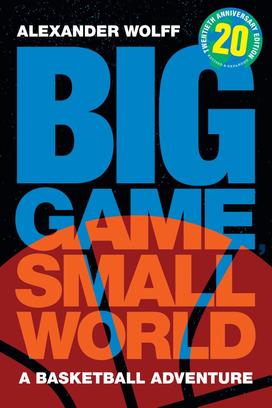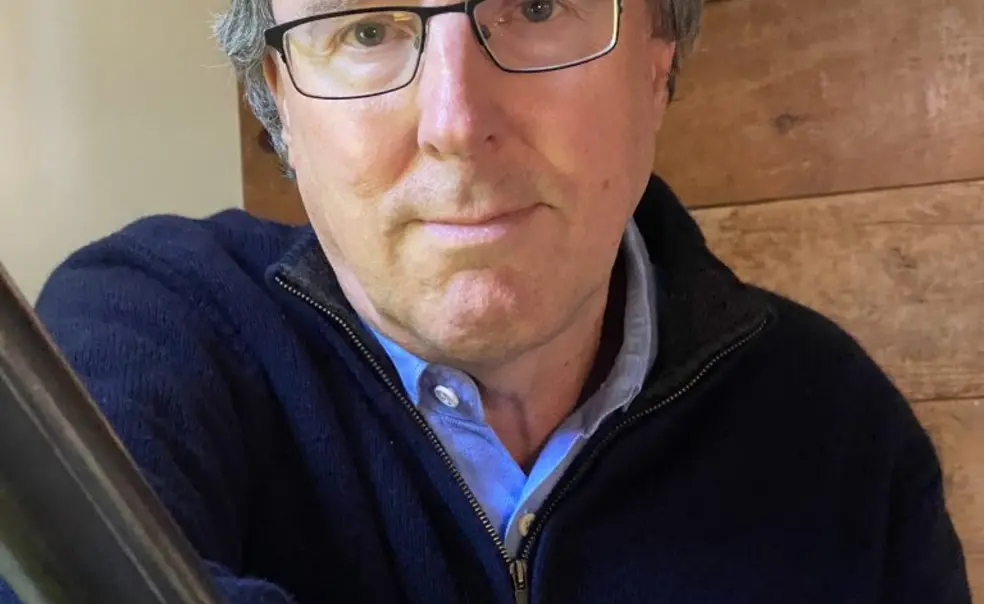Alexander Wolff ’79 Celebrates the History of Basketball in Anniversary Edition of his Classic Book
The book: In this revised and expanded 20th anniversary edition of the classic book Big Game, Small World (Duke University Press), author Alexander Wolff ’79 analyzes the game of basketball in the broader context of life. The book includes dispatches from 16 countries to understand the history of basketball. This version features updates to each chapter and a new preface where Wolff reflects on the rise of athlete-activists. This loving celebration of basketball explores the history of how the sport grew into a global phenomenon. 
The author: Alexander Wolff ’79 is an award-winning sports journalist. He was a writer for Sports Illustrated for 36 years covering basketball, the Olympics, the World Cup, the World Series, every Grand Slam tennis event, and the Tour de France. He graduated from Princeton with a degree in history and served as a Ferris Professor of Journalism at the University in 2002. He is the author or co-author of seven books including Raw Recruits and The In-Your-Face Basketball Book.
Excerpt:
My father is an immigrant who left Germany in 1948 to study chemistry at Princeton. After earning his PhD he took a research job with RCA just outside town. Growing up, I did not toss a baseball with my dad in the backyard. He had broken his nose three times playing field hockey as a schoolboy in Bavaria, and his eagerness to assimilate never overcame a vow to swear off ball games of all types. But our family pediatrician told my American-born mother that, for orthopedic reasons, he preferred basketball to other sports, and my mom channeled doctor’s orders into a subtle encouragement to play hoops.
At the same time, Bill Bradley was installing himself as a local hero. He would be written up at great and approving length in the pages of the New Yorker, a publication that held truck in our household. Studious, cleancut, and churchgoing, Bradley appeared to be wholly admirable, and though my parents were baffled by his devotion to a sweaty game, it seemed to be part of a larger, disciplined approach to life, and for basketball they were prepared to excuse him. One of my earliest memories dates to December 1964, when I was put to bed so my parents could watch Bradley and Princeton hook up with Cazzie Russell and Michigan on TV in the semifinals of the ECAC Holiday Festival. This has stuck in my head, I think, not so much because of my disappointment at missing the game, but because I don’t recall my parents ever again accommodating their lives to a televised sporting event.
As a result of the unlikely status basketball held in our home, my parents hadn’t removed the hoop put over the garage by the previous owners. And so I found myself spending many hours alone beneath it. I played even when the net, rigid from rain and cold, would catch my shot fast, and I’d have to whack the ball free with a broom handle after each basket. Nevertheless, in the act of trying to send a ball through a hoop I found hours of solitary pleasure. At an annual summer carnival in town I discovered that I could sink a shot better than most kids my age. Even after my father left RCA for Xerox and we moved to a suburb of Rochester, New York, I ignored the vogue for ice hockey in our new neighborhood and went on to become a decent high school player on a decent high school team. But I wasn’t good or big enough to play at the summit of the Ivy League. So upon returning to Princeton for college I began covering campus news for the Trenton Times, an evening paper down Route 1.
I took a frontrow seat in Carril’s lecture hall, sometimes typing out a skeletal play-byplay for the sports information office. For that duty—for coming up with pithy gems like “Sowinski 15-ft jump” and “Omeltchenko 2-ft, Good, Good”—I received $15 a game and a taste of my future profession. My greatest failure as a player had always been a reluctance to mix it up, and this extracurricular choice would complete my transit from participant to observer. From time to time I regretted not having tried out for the team. This wasn’t because I believed I could have made it, much less made any contribution. It was because to watch Princeton play was to be reminded repeatedly of why I loved the game.
Yes, I adored basketball for its style and argot, its racial ecumenism, its jaunty, loose spirit. But the Tigers under Carril pulled off something just as appealing. Canny, throwback, almost pious in their respect for each possession, they seemed to share an intuitive understanding of Newton’s third law. Their offense flowed away from the ball, with players moving in opposition to defensive pressure. The transcendent Princeton moment — the Tigers’ earthbound answer to the alley-oop dunk—was the backdoor layup, the play available when the balance of an opponent has tipped irretrievably away from the goal he’s supposed to defend. Think of the reverse commuter at rush hour, or the martial artist well-practiced at jujitsu. The overdefended player cuts to the basket, then takes a teammate’s pass for two easy points. If its constituents can all pass, move, and shoot, and no one cares who ultimately scores, a team running a backdoor offense will press against the limit of its potential, while the opposition suffers death by a thousand back cuts.
Treated regularly to so artful a display of the game, I was hardly able to abandon its practice. For my first two years on campus I drifted over to musty Dillon Gym in the afternoons to play pickup. I abandoned college after my sophomore year, kiting off to Switzerland to spend a season with a club team there. To my parents’ relief I eventually came back to school. But the summer after junior year, a buddy and I threw a ball into the trunk of a car and vagabonded around the United States in search of the perfect pickup game, then wrote up an account of our journey called The In-Your-Face Basketball Book.
So to me notions of movement have always attended the game. Indeed, basketball owes its very existence to human mobility: It was invented in Springfield, Massachusetts, by a Canadian immigrant, Dr. James Naismith, at the International YMCA Training School, which was chartered to groom missionaries. When Bradley won two NBA titles with the New York Knicks, he catalyzed the team as a hyperkinetic forward, helping to enshrine perpetual motion as one of the great virtues of offensive play. Today there is still no greater crime against the game than to “stand around”; no compliment—not “nice pass,” not “good shot”—gladdens a player’s heart more than “sweet move.”
Princeton had been the site of my childhood fascination with the game. It had indulged my affection when I was a college student there. Now, nearly 20 years out, the school figured in my summons. During the 1996 NCAA tournament, Pete Carril made his final victory a 43–41 upset of defending national champion UCLA, with the Tigers winning on their signature play in the game’s dying seconds. Then, two years later, Princeton spent most of the season in the Top 10, losing only twice. The Tigers had long been regarded as a “visit to the dentist” team that would numb opponents with the Novocaine of 10, 15, 20 passes or more before applying the drill. Yet here they were drilling patients without anesthesia. They’d never passed so deftly, cut so hard, or scored so audaciously. With play so selfless that in one game each of its 21 baskets came on an assist, Princeton drew the attention of every segment of the mainstream media and won legions of new followers, all curious to know how a school that couldn’t offer athletic scholarships consistently found wide-open layups against national powers.
At times that season Princeton hardly seemed to need a coach. During their all-assist game, at the ECAC Holiday Festival, the Tigers found themselves momentarily bamboozled after Niagara jumped into a zone defense. The man who had succeeded Carril, Bill Carmody, called timeout to tell his players nothing more than this: “You’re smart guys. You figure it out.” In that long-ago Holiday Festival semifinal my parents hadn’t let me see, Princeton lost a lead and ultimately the game after Bradley fouled out. Thirty-three years later the Tigers scored those 21 assisted baskets in the very same tournament. Having evolved from a gross dependency on a single player to a consummate interdependency, this time they won the Holiday Festival, in as fine an example as any of basketball virtue rewarded.
Princeton’s remarkable year set me to wondering whether the Tigers didn’t embody a kind of hoops metaphysics. Carmody hinted that something Eastern sat at the heart of the team’s approach. “We run a lot of yin stuff,” he said at one point during that season. “Oak tree, willow tree—you know.” Carril had preferred to sound a note more in keeping with Western moral philosophy. “Guys who come around to the ball just feed greed and ignorance,” he once told me. Whatever their provenance, Princeton’s precepts worked, and I tried applying them when I took the court for my regular Wednesday night run in a rented gym on the Upper West Side.
I vowed to pass and cut away, and never to come around to the ball—to spread love rather than greed and ignorance. Of course, in the hurlyburly of a pickup game this made me the crank screaming “Repent!” in Times Square at rush hour, and I quickly reverted. But I was at least looking at basketball with a heightened consciousness.
And then, during the second half of Princeton’s game with Brown that February, I had my epiphany. From where he dribbled to the right of the key, one of the Tigers’ seniors, Mitch Henderson, saw a teammate bolt toward the basket from the opposite wing. In a trice the ball left his hands and found its way, on a bounce, through a bramble of bodies in the lane and into the hands of another senior, James Mastaglio, for a layup. Or so I believed; I wasn’t sure that what I thought I’d seen was even possible. I checked with one of the people who had by now flocked to follow the Tigers. The bard of the ballparks, Washington Post columnist George Will, sat next to me on press row, and confirmed that Henderson had indeed whipped a pass through and past most of the players on the floor. My neighbor wasn’t wearing his usual bow tie, but if he had been it might have spun cartoonlike on the top button of his Oxford shirt. It occurred to me: If George Will could write rhapsodic essays on the Jeffersonian origins of the infieldfly rule, surely there was a thing or two worth saying about hoops.
“The appeal of basketball is that it is a game easy to play, but difficult to master,” Doc Naismith once said. In that lacuna between just playing— “piddling at it,” as Naismith put it—and perfection, people could get blissfully lost and pull off wonderful things. Mitch Henderson’s crosscourt backdoor bounce pass through traffic had been one of those wonderful things. It moved me like a prod.
Reprinted with permission from Big Game, Small World: A Basketball Adventure by Alexander Wolff, Copyright Duke University Press, 2022. All rights reserved.
Reviews
“His reporting is terrific. The most entertaining chapters focus on people torn between their love of the game and conflicting, often incongruous forces.” — The New York Times Book Review
“Wolff has a great feel for basketball and the people who love the game.” — John Feinstein, author of A Season on the Brink












No responses yet